Ambient Decorations
Reminder - Keep Daily Backups
When working on a strategy game with a kit as big as the Complete Kit - always keep a working daily backup! Save yourself the trouble of rolling-back changes and losing work.
What are decorations?
When playing city-building games or battle strategy games you'll always be able to build some sort of structure that doesn't have any economic role or even defensive role but just looks pretty and gives players a way to personalize their base and also spend extra currency. In this case we've added a category in the store for you to place these objects like flagpoles, statues, or flowers.
The demo includes an assortment of these objects for you to play around with when designing your own game.
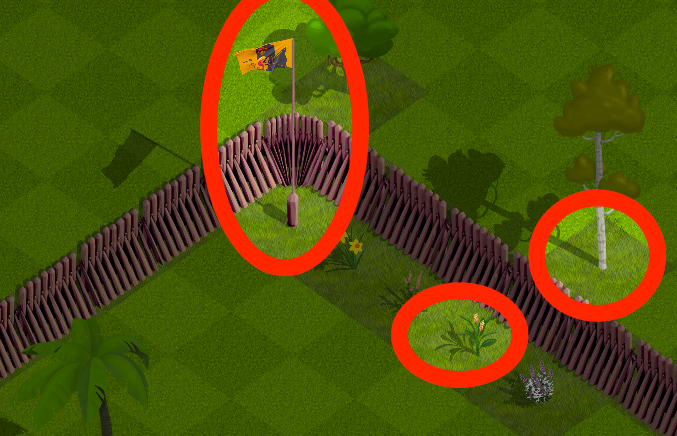
Purchased decorations. Click to view larger.
Shop Menu
Here's a screenshot of the shop menu for the decorations which we call ambient objects in the kit. (since they have no defense, offense, or HP and cannot be attacked)
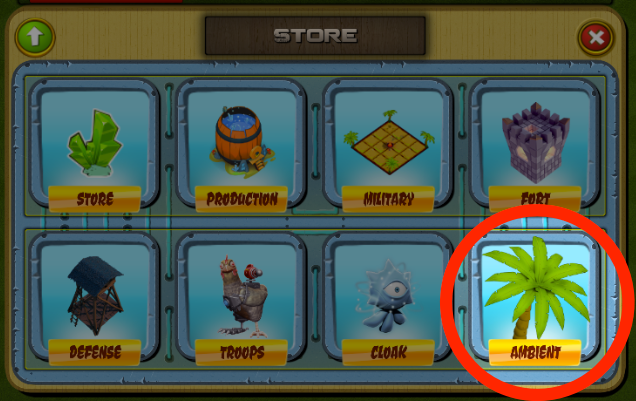
Click to view larger.
The examples here are general ambient objects that do not affect the player's stats except awarding XP for completion and costing resources to build. You can adjust any of these settings. (Details below on how to do this in the XML.)
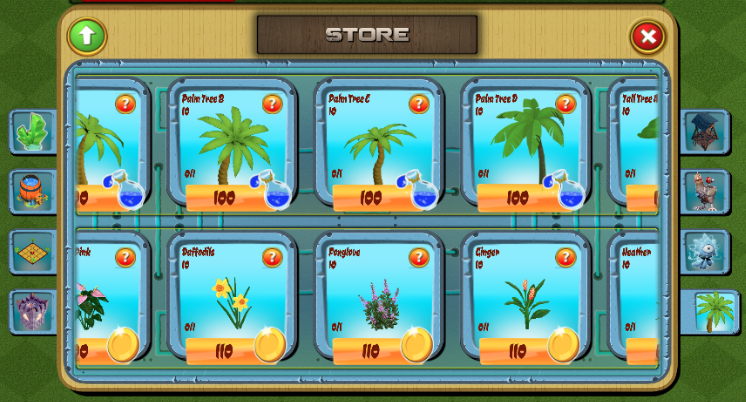
Click to view larger.
Where to find the decoration store items in Unity
Open the game scene hierarchy and locate the ScrollViewAmbient in UIAnchor > Anchor - Center > Shop > Main. Look at the below screenshot.
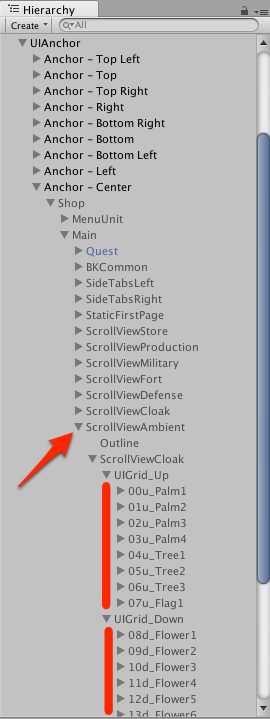
UIAnchor. Click to view larger.
Store Item UI
All of the store details seen in the below screenshot are taken from the XML/Ambient.xml file and loaded by Scripts/Creators/BaseCreator.cs (details below on what part of the script does this)
Although the screenshot below is for another building type in the store, the details apply to all buildings including ambient objects since the store uses centralized BaseCreator.cs script.
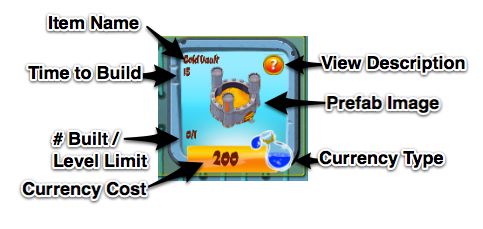
Breakdown of the information shown to players in the store.
| From Image Above | Description |
|---|---|
| Item Name | This is the Name variable from XML/Ambient.xml |
| Time to Build (in minutes) | The TimeToBuild variable (in minutes) from Ambient.xml. How long the structure will take to to be created. |
| # Build / Level Limit | The number of this structure already created versus the number limited by their level in XML/EvolutionBuildings.xml. See Gameplay > XP and Levels documentation for details) |
| Currency Cost | The Price variable from XML/Ambient.xml |
| Currency Type | The Currency variable from XML/Ambient.xml (Either Gold, Mana, or Gems) You could change this to whatever currency you will have in your game and also add additional currencies. |
| View Description | Shows the Description text variable from XML/Ambient.xml |
| Prefab Image | The prefab image which you can edit from the UIAnchor: Center shop main menu. More details on how to change this under the Buildings > Part 2: Customize Menus page of the documentation |
Item Example
Here's an item example from the XML/Ambient.xml for the Flag seen in the store.
<Ambient>
<Name>Flag</Name>
<!-- name displayed in the store -->
<Description>Flag description.</Description>
<!-- description displayed in the store -->
<Currency>Gold</Currency>
<!-- save as Gold, Mana, Crystals to buy -->
<Price>100</Price>
<!-- amount of resource necessary to pay for the object -->
<TimeToBuild>10</TimeToBuild>
<!-- the time (in minutes) needed to create the building -->
<XpAward>100</XpAward>
<!-- experience awarded for the completion of building this -->
</Ambient>
A closer look at object XML
If you look closely in the above XML, you'll see the building costs 100 of of the Gold currency. You could use whatever currency you want in your game, in the demo we have two placeholders called Gold and Mana. (Plus one rare currency called Crystal Gems).
<Currency>Gold</Currency>
<Price>100</Price>
Further down in the XML you'll notice it will take 10 minutes to build (TimeToBuild is measured in minutes) and awards 100 XP to the player when the item is constructed.
<TimeToBuild>10</TimeToBuild>
<XpAward>100</XpAward>
If you don't want to award XP and also want the decoration to be built instantly, change both of these values to 0 like this example:
<TimeToBuild>10</TimeToBuild>
<XpAward>100</XpAward>
Another XML Example
<Ambient>
<Name>Palm Tree A</Name>
<Description>Palm Tree description.</Description>
<Currency>Mana</Currency>
<Price>100</Price>
<TimeToBuild>0</TimeToBuild>
<XpAward>100</XpAward>
</Ambient>
You'll notice the only major change is that the currency is different and this object does not take any time to build.
BaseCreator.cs - Where the XML is loaded into
In Scripts/Creators/BaseCreator.cs the building data from your XML file (seen above) is loaded using a common system for all the buildings like resource buildings, defense buildings, walls, decorations, and other buildings. Here's an excerpt from BaseCreator.cs of the XML data load:
//reads ambient object XML
protected void GetAmbientXML()
{
XmlDocument xmlDoc = new XmlDocument();
xmlDoc.LoadXml(StructuresXML.text);
XmlNodeList structureList = xmlDoc.GetElementsByTagName(structureXMLTag);//"Wall"
foreach (XmlNode structureInfo in structureList)
{
XmlNodeList structureContent = structureInfo.ChildNodes;
dictionary = new Dictionary<string, string>();
foreach (XmlNode structureItem in structureContent)
{
// For each of the XML values, it stores the information
// to be used later in BaseCreator.cs
if(structureItem.Name == "Name")
{
dictionary.Add("Name",structureItem.InnerText);
// put this in the dictionary.
}
if(structureItem.Name == "Description")
{
dictionary.Add("Description",structureItem.InnerText);
// put this in the dictionary.
}
if(structureItem.Name == "Currency")
{
dictionary.Add("Currency",structureItem.InnerText);
}
if(structureItem.Name == "Price")
{
dictionary.Add("Price",structureItem.InnerText);
}
if(structureItem.Name == "TimeToBuild")
{
dictionary.Add("TimeToBuild",structureItem.InnerText);
}
if(structureItem.Name == "XpAward")
{
dictionary.Add("XpAward",structureItem.InnerText);
}
}
structures.Add(dictionary);
}
}
When the data is loaded, the store panels are updated with the appropriate information.
Construction limits with XP levels
Read the Gameplay > XP and Levels documentation page for more details about how the XML/EvolutionBuildings.xml file limits the number of certain Building.xml structures per level.
Although the following example is not an ambient object, it's a good example to show since the store elements all act the same in the store menus.
For example, game players could have a maximum of two gold mines at level one until the player reaches level two, in which the maximum increases to five (or whatever value you choose -- read XP and Levels documentation for more details)
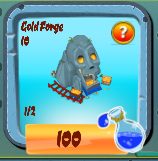
1/2 gold mines built. Maximum not reached.
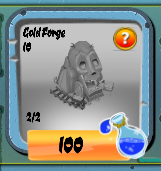
2/2 maximum reached, can't build more
This is relevant to mention now because the menu items are greyed out for objects that the player can no longer build until they increase their XP level through other ways of gaining XP.
The function UpdateLabelStats() does this checking in Scripts/Creators/BaseCreator.cs
// Excerpt from UpdateLabelStats()
// Check if the player is looking at items in the store that
// would exceed their XP level limits
buildingAllowed =(allowedStructures[i]-existingStructures[i]>0);
// Set the store item's label data
NameLbs[i].text = structures [i] ["Name"];
TimeLbs[i].text = structures [i] ["TimeToBuild"];
// Quantity - for example, 2/2 means they have reached the maximum of 2
QuantityLbs[i].text = existingStructures[i].ToString()+"/"+allowedStructures[i].ToString();
PriceLbs[i].text = structures [i] ["Price"];
// If they can build, set the normal store item background and label colors
if(buildingAllowed)
{
NicheSprites[i].spriteName = "stone_niche";
PortraitSprites[i].atlas = Portraits;
NameLbs[i].color = brown;
TimeLbs[i].color = brown;
QuantityLbs[i].color = brown;
PriceLbs[i].color = brown;
// If the player can no longer build this item, grey out the item in the store
} else {
NicheSprites[i].spriteName = "stone_niche_bw";
PortraitSprites[i].atlas = PortraitsBW;
NameLbs[i].color = black;
TimeLbs[i].color = black;
QuantityLbs[i].color = black;
PriceLbs[i].color = black;
}
What happens when the buy button is clicked?
When the player clicks one of the buttons to build an ambient object in the store, first one of the standard centralized building functions is triggered, like this example below:
//receive a NGUI button message to build
public void OnBuild0() { currentSelection=0; Verify(); }
//when a building construction menu button is pressed
Verify() is run shortly after, which initiates the conditions checking to see if the player actually can build what they want to build.
private void Verify()
{
if (isArray[currentSelection] == 0)
{
VerifyConditions ();
}
else
{
isField = true;
drawingField = true;
Delay ();
VerifyConditions ();
}
}
VerifyConditions()
Can the player build this structure? In Scripts/Creators/BaseCreator.cs the VerifyConditions() script takes over once the store button has been pushed to determine if the following conditions are met and canBuild is set to true.
VerifyConditions() Test #1 - Maximum structures reached?
First, we check if the player's level restricts the structure from being made. Have they exceeded the number of structures allowed by their level in XML/EvolutionBuildings.xml? (See Gameplay > XP and Levels documentation for more information on this)
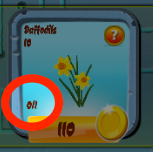
0 of 1 maximum decorations built for my current level.
if (existingStructures[currentSelection] >= maxAllowed){
// Max already reached
// Fails the first test, set canBuild = false
canBuild = false;
// Throws an error message in the in-game messanger
((Messenger)statusMsg).DisplayMessage("Maximum " + maxAllowed.ToString() +
" structures of type " +
structures [currentSelection] ["Name"]+". ");
// Displays the hint:
// you can have only X structures of this type for their level
}
VerifyConditions() Test #2 - Do they have enough funds?
The second test the player data must pass is their funds - do they have enough of the currency the building requires to be constructed?
// Get the building cost
int price = int.Parse (structures [currentSelection] ["Price"]);
// If the building cost is in Gold, do they have enough gold?
if (structures [currentSelection] ["Currency"] == "Gold"){
// Finding out how much gold they have remaning if you subtract it
int existingGold = ((Stats)stats).gold + ((Stats)stats).deltaGoldPlus - ((Stats)stats).deltaGoldMinus;
// See if the gold remaining is less than the price
if (existingGold < price)
{
// not enough
canBuild = false;
((Messenger)statusMsg).DisplayMessage("Not enough gold.");
//updates hint text
}
// Repeat the same above, but instead for the other currency (Mana)
}
else if (structures [currentSelection] ["Currency"] == "Mana")
{
int existingMana = ((Stats)stats).mana + ((Stats)stats).deltaManaPlus - ((Stats)stats).deltaManaMinus;
if(existingMana < price)
{
canBuild = false;
((Messenger)statusMsg).DisplayMessage("Not enough mana.");//updates hint text
}
// Repeat the same above but for the rare Crystal currency
// If you have additional currencies in your game, uncomment the //
// and repeat for each currency
}
else //if (structures [currentSelection] ["Currency"] == "Crystals")
{
int existingCrystals = ((Stats)stats).crystals + ((Stats)stats).deltaCrystalsPlus - ((Stats)stats).deltaCrystalsMinus;
if(existingCrystals < price)
{
canBuild = false;
((Messenger)statusMsg).DisplayMessage("Not enough crystals.");//updates hint text
}
}
VerifyConditions() Test #3 - Do they have an available builder?
In the City Building Kit each building under construction takes one builder. Players get a certain number of builders to start with (default is 1 in the demo) and you can adjust this for your game. It costs extra rare gems to get additional builders like games such as Clash of Clans. (The builder hut is called a dobbit hut in the demo, read the Shop Menu > Resource Generators section on builders for more details.)
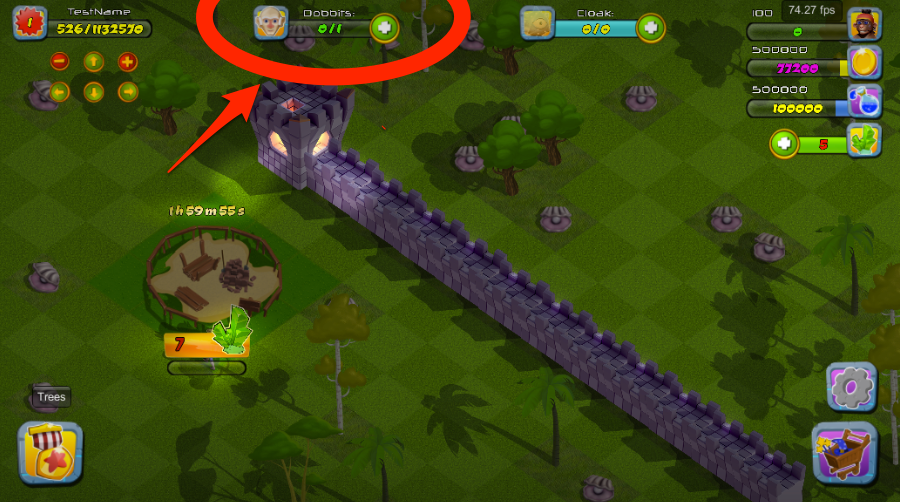
No builder available for a second construction project in this screenshot. Click to view larger.
//builder available?
if (((Stats)stats).occupiedDobbits >= ((Stats)stats).dobbits)
{
canBuild = false;
((Messenger)statusMsg).DisplayMessage("You need more dobbits.");
}
VerifyConditions() - If all tests pass, greenlight construction.
If the player's data passes all 3 tests and canBuild still is set to true, then the script adjusts the player data awarding the XP they get from the building XML (if any) and deducting the costs involved from the building currency and price.
if (canBuild)
{
((MenuMain)menuMain).constructionGreenlit = true;
//ready to close menus and place the building;
//constructionGreenlit bool necessary because the command is sent by pressing the button anyway
((Stats)stats).experience += int.Parse (structures [currentSelection] ["XpAward"]);
//increases Stats experience
// move this to building finished
if(((Stats)stats).experience>((Stats)stats).maxExperience)
{
((Stats)stats).level++;
((Stats)stats).experience-=((Stats)stats).maxExperience;
((Stats)stats).maxExperience+=100;
}
//pays the gold/mana price to Stats
if(structures [currentSelection] ["Currency"] == "Gold")
{
((Stats)stats).SubstractResources (price, 0, 0);
}
else if(structures [currentSelection] ["Currency"] == "Mana")
{
((Stats)stats).SubstractResources (0, price, 0);
}
else //if(structures [currentSelection] ["Currency"] == "Crystals")
{
// Repeats the same above but for the rare Crystal currency
// If you have additional currencies in your game, uncomment the //if(structures
// above and repeat for each currency in your game
((Stats)stats).SubstractResources (0, 0, price);
}
UpdateButtons ();//payments are made, update all
((Stats)stats).UpdateUI();
//tells stats to update the interface - otherwise new numbers are updated but not displayed
if (!isField || buildingFields)
{
UpdateExistingStructures (+1);
//an array that keeps track of how many structures of each type exist
InstantiateStructure ();
}
}
else
{
((MenuMain)menuMain).constructionGreenlit = false;
//halts construction - the button message is sent anyway, but ignored
}
ConstructionGreenlit = true is sent the MenuMain script which then deactivates the store panel the player was just on and waits for the building to be placed.
((MenuMain)menuMain).constructionGreenlit = true;
// ready to close menus and place the building;
// constructionGreenlit bool necessary because the command is sent by pressing the button anyway
Updated less than a minute ago
